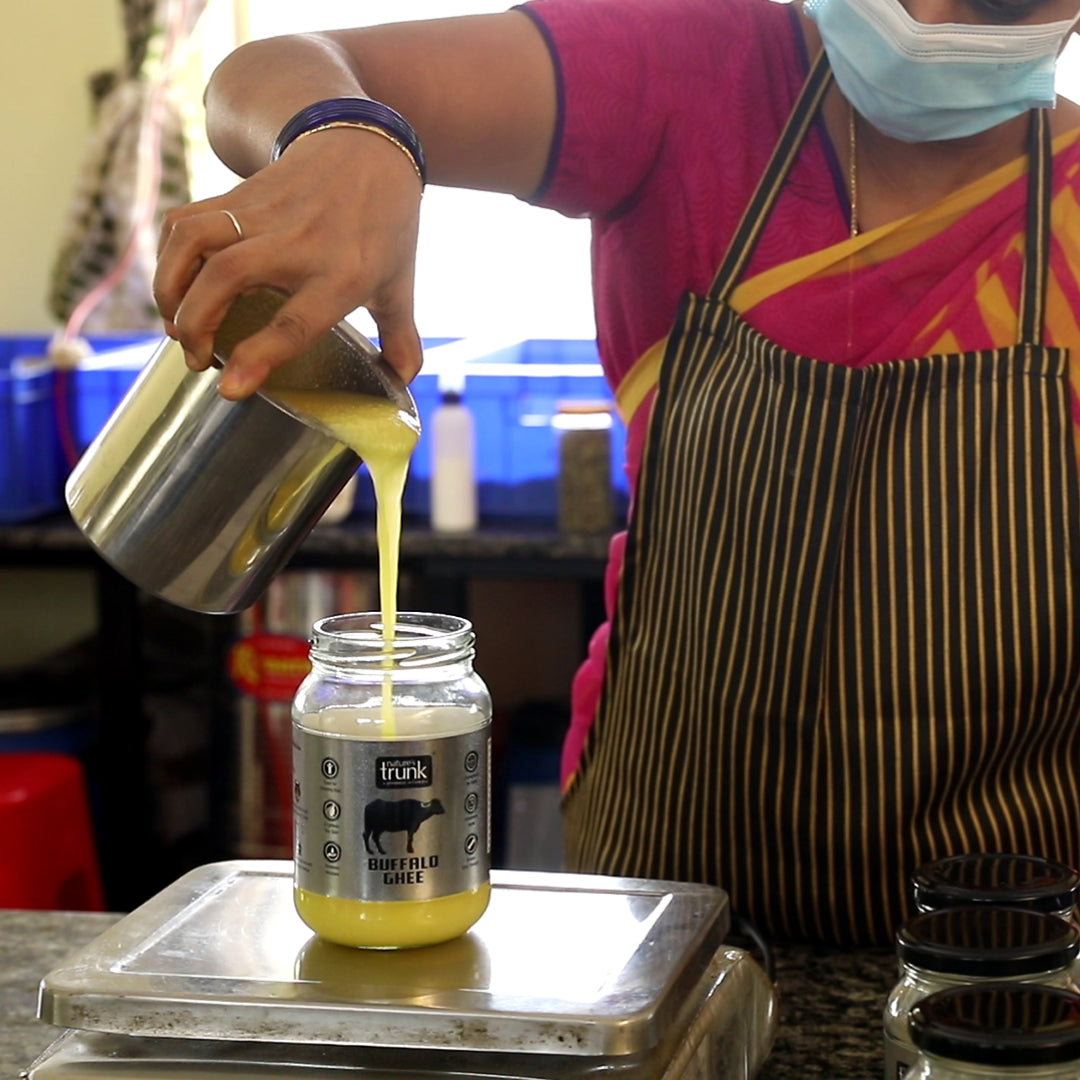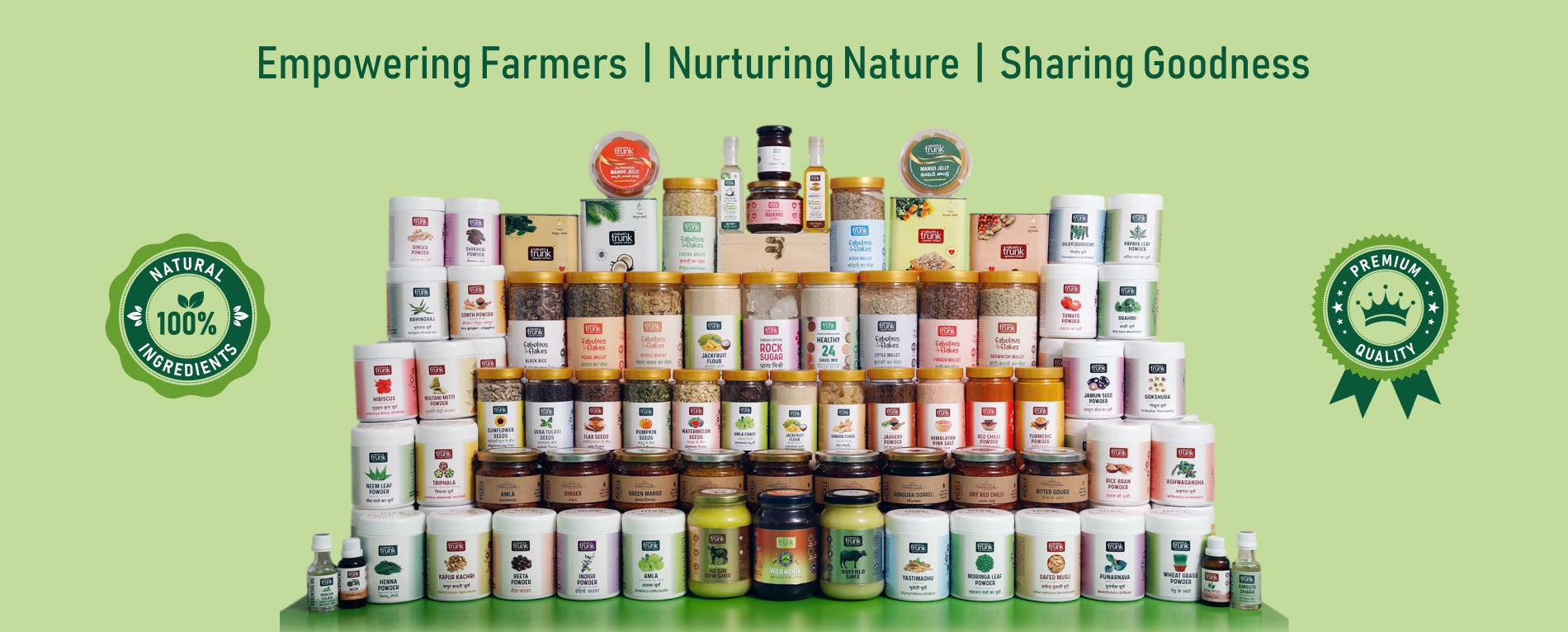*Get Extra 5% Off on Prepaid Orders*
*All Over India Free Shipping above ₹649/-*
*Cash on Delivery Available*
*Get Extra 5% Off on Prepaid Orders*
*All Over India Free Shipping above ₹649/-*
*Cash on Delivery Available*
*Get Extra 5% Off on Prepaid Orders*
*All Over India Free Shipping above ₹649/-*
*Cash on Delivery Available*
*Get Extra 5% Off on Prepaid Orders*
*All Over India Free Shipping above ₹649/-*
*Cash on Delivery Available*

Nature's Trunk is a brand with a passionate team of individuals driven by a mission to empower farmers and connect them directly with consumers. We are a close-knit fraternity of farmers, experts, and curators working together to bring you the finest, most authentic farm-based products.
We champion chemical-free farming methods, respecting both the environment and your health.

From super foods to indigenous cattle products, we curate a diverse selection of ethically sourced delicacies.

We bypass middlemen, ensuring fair prices for farmers and competitive rates for consumers.

We employ advanced farming techniques to guarantee the consistent quality and freshness of our produce.

We believe in building a strong farming fraternity and fostering positive change with in the industry.


• Handcrafted Products:
Made with meticulous attention to detail by over 500 skilled curators across India.
• 100% Natural Ingredients:
No harmful chemicals or additives, just pure, unadulterated goodness.
• Curated Selection:
Super foods, desi ghee, wild honey, millets and more - catering to diverse preferences and dietary needs.
• Always Fresh:
Local sourcing & making in small batches ensures our products reach you directly from the farm, bursting with natural flavour and nutrients.
• Sustainable Practices:
We champion eco-friendly methods for the well-being of our planet and your health.

Empower farmers: Eliminate middlemen and ensure fair compensation for their hard work.
Promote sustainability: Advocate for eco-conscious farming practices that nurture the Earth.
Deliver exceptional quality: Offer consumers the freshest, most authentic farm-to-table experience.
Ensure transparency: Provide complete clarity throughout the supply chain, building trust with our customers.
Build a strong community: Create a thriving network of farmers, consumers, and supporters who share our values.
Many Indian households love Paneer and use it in multiple dishes because of its soft, creamy texture & protein-rich. But did you know that the Paneer you consume contains food additives that increase the risk of cancer? Shocking, isn’t it? Now let us unveil the secret behind mass-produced Paneer and how you can get reliable processed Paneer without worrying about your health. What makes Paneer Dangerous? The rise in dairy demand allows manufacturers to take shortcuts and add synthetic chemical preservatives as well as whiteners to make the product last longer. These additives are known to augment cancer and severely harm health. Top 4 Additives in Paneer that Cause Cancer & other Illnesses 1. Formalin (Formaldehyde) - The Silent Killer Formalin is a chemical aimed at preventing decay; it is heavily used in mortuaries to store dead bodies. The International Agency for Research on Cancer (IARC) has identified Formalin as a type one carcinogen. As painful as it sounds, the long-term effects of consuming Paneer laced with Formalin are even more painful, as they can result in leading diseases such as cancer. 2. Starch - Some cheap filler that could kill you In some cases, manufacturers also add starch to increase the weight of Paneer so that it looks fresh and firm. Starch by itself isn’t harmful, but adulterated starch or chemically treated starch can lead to digestive problems and insulin resistance and may even increase the risk of cancer. 3. Hydrogen Peroxide - An Extremely Dangerous Bleaching Agent To make Paneer appear whiter and more appealing, some producers use Hydrogen Peroxide, a bleaching agent that is not safe for human consumption. Studies have found that long-term exposure to Hydrogen Peroxide is linked to stomach and intestinal cancers. 4. Synthetic Milk—A Mixed Tale of Toxins In India, adulterated milk is a serious issue. To increase the volume of milk, many local dairy vendors mix detergents and urea along with synthetic chemicals. These chemicals thus remain in the product and create serious health hazards when Paneer is made from synthetic milk. How Can One Easily Detect Adulterated Paneer? 1. Water Test: Place a small piece of Paneer in a glass of warm water. If the water becomes murky or milky, it indicates starch. 2. Smell Test: Paneer has to have a pleasant, enticing smell of milk. In case the smell of Paneer is extreme and super strong, it suggests that the Paneer has been seasoned with formalin and preservatives. 3. Iodine Test: Stick a few drops of Iodine solution into the Paneer. If it changes to blue or black, then starch is confirmed to be present. How to do this Safely and Effectively - 1. Buy Local Farm Fresh Paneer Look for labels that say organic or farm-fresh Paneer that is not processed with synthetic chemicals. Look for trusted certifications on the packaging. 2. Prepare Paneer at your Home Use pasteurized milk to prepare pure Paneer at home. Bring milk to a boil, then squeeze lemon juice or vinegar into it. Pour the mixture through a strainer to get fresh Paneer. 3. Buy them from Trusted Vendors Help local milk providers and well-known firm brands that focus on ethical milk selling regarding preservatives. 4. Ensure to Cross Check the Labels When buying store-bought frozen Paneer, be sure to check the ingredients. Don't buy products that have too many unfamiliar chemical names or any kind of stabilizers or preservatives. In Conclusion- Your lifestyle is in your control; Be sure to take care of it! Using rides on safer choices, making background checks on the vendors you buy from, and having more focus on dairy hygiene laws, you could greatly enhance your quality of life. Cut down on the unhealthy consumerism and help educate those around you. So, how did your test on the Paneer go? Have you made assumptions on its adulteration? Make sure to comment below so we can work together towards a healthier future.
Everything from tea and coffee to sweets and even food wrappers is infused with sugar. And who knew that White Sugar is taken away from its nutrients and yields only empty calories? Want something better? Jaggery (Gud/Gur) can be the solution. This time-tested sweetener is full of vital minerals and health benefits and hence a smarter option than White Sugar. Wondering why and how? Find out below! What is Jaggery? Jaggery is a natural unrefined sweetener produced by boiling Sugarcane Juice or Palm SAP or Date Palm SAP or Coconut SAP etc., While White Sugar is highly processed, i.e., loses all its nutrients like iron, potassium, magnesium, and antioxidants, Jaggery does not. But does it actually offer anything else apart from sweetness? Let us find out its health benefits. Health Benefits of Jaggery 1. Rich in Nutrients Rich in vitamins and minerals, Gud is far better than Sugar, which lacks nutrients. It can be tapped for antioxidants that enhance immunity and give a pickup in the form of energy, besides iron, calcium, and magnesium. 2. Digestive Aid Do you feel gassy after eating? Consuming a small amount of Gud / Gur after meals can stimulate digestive enzymes, which will help in better digestion and avoid constipation. 3. Immunity Boost Gud has minerals and antioxidants in it, which detoxify the body, eliminate toxins, and enhance immunity. It is of great benefit during climate change when the body can be easily infected. 4. Detoxifies Your body gains toxins every day from pollution, processed foods, and unhealthy food habits. Gud is a natural purifier that cleanses the liver and cleanses the blood. 5. Keeps Blood Pressure The potassium and magnesium content in Jaggery keep body electrolytes balanced, preventing blood pressure and helping heart wellness. 6. Weight Loss Jaggery provides energy in a natural form without any momentary increase in sugar. Jaggery tends to keep you satiated longer, preventing temptations and excessive hunger, and therefore is ideal for the diet follower. 7. Relieves Menstrual Cramps Jaggery is a natural remedy for women's menstrual cramps. It manages mood swings and bloating, two PMS symptoms, and regulates hormone imbalance. 8. Skin Health Does your skin feel dull or have acne? Jaggery antioxidants fight free radicals and provide your skin with a youthful, clear, and bright appearance. Jaggery Types You might not know that Jaggery / Gud come in many different types, each with its own benefit. Sugarcane Jaggery is prepared from fresh sugarcane juice, which is a staple in Indian households. Palm Jaggery / Palm Gud is prepared using palm tree sap and contains different minerals and a caramel-flavoured taste. Date Palm Jaggery is used in Bengali and Southeast Asian cooking and is prepared from date palm sap. Coconut Jaggery is a less sweet and healthier alternative prepared from coconut sap. All these Jaggeries are rich in nutrients; thus, they are a better choice than white sugar. Organic Jaggery Vs Normal Jaggery (Sulphur-Contained) All Jaggeries are not the same. Processing provides it with an advantage or drawback in terms of its health benefits. Organic Jaggery ✅ Chemical-free and preservative-free ✅ More nutrients retained due to natural processing ✅ No sulphur addition for a natural and safe product Normal (Sulphur-Contained) Jaggery ❌ At times processed with chemicals such as sulphur dioxide that may be injurious to health ❌ May have additives used for improving colour and texture ❌ Too much processing causes the loss of some of its own natural minerals. To get the purest Jaggery, always choose organic Jaggery while choosing it for its medicinal properties. How to use Jaggery instead of Sugar? Switch from Sugar to Gud easily! Here are some easy ways to start: In Tea or Coffee: To prepare a healthy tea or coffee, substitute natural Jaggery Powder for Refined Sugar. In Desserts: In cake, halwa, and kheer, substitute Sugar with Jaggery. As a Digestive Aid after Meals: Consume a little amount of Gud after meals for easy digestion. In Detox Drinks: Mix nuts with hot water and lemon to make a natural detox drink. In Energy Bars: Mix nuts and seeds with Jaggery to make healthy energy bites. In Conclusion: Best Replacement of Sugar - Jaggery If you need a healthier, more natural, and more nutritious sweetener than White Sugar, jaggery is your choice. Not only for sweetness but also for digestion, boosting immunity, and energizing the body. But don't forget—moderation is the key! Jaggery does have natural sugars, so have it in moderation to reap its advantages without overconsumption of calories. Know more 1. Is Jaggery better than Sugar? Yes, Gud is mineral and antioxidant-rich and thus a healthier choice than plain sugar. 2. Diabetics, should they consume Jaggery? Gur contains high GI, and thus diabetics need to have it in moderation or consult a doctor before incorporating it into their diet. 3. How much should be taken daily? 1 to 2 teaspoons a day is the optimum quantity to reap its advantages without adding extra calories. 4. Is Jaggery a temporary product? Jaggery, when stored well, can last for 6-12 months without any loss of quality.
Struggling with Painful Ulcers? This sweet remedy can help you! Mouth ulcers and stomach ulcers can be frustrating, making eating and drinking a painful task. Spicy foods, stress, and acidity make the pain worse. Although medicines provide relief for a short while, wouldn't it be wonderful if there were a natural, long-term cure? Gulkand is an ancient Ayurvedic medicine prepared from Damask Rose Petals and Daga Mishri (Rock Sugar). For its cooling and curative nature, Rose Petal Jam cures ulcers, quiets inflammation, and keeps the digestive system healthy in a natural manner. Let's see why this lovely jam is the ideal cure for ulcers! What is Gulkand? Gulkand is an Ayurvedic medicine made by sun-cooking Damask Rose Petals and Daga Mishri (Rock Sugar) for weeks. Natural fermentation enhances its nutrients like Vitamin B, antioxidants, and medicinal properties, and it is a very good medicine for digestive issues, acidity, and ulcers. Unlike chemically processed rose syrups, sun-cooked Gulkand (Rose Jam) does not lose its purity and medicinal properties because there are no chemicals or preservatives involved. How Gulkand Helps with Ulcers 1. Relieves Mouth Ulcers Mouth ulcers are painful and irritating while eating or drinking. Gulkand has vitamin B, and its natural cooling effect reduces inflammation and provides you instant relief. ✅ How to Use: Use a small quantity of Gulkand directly on the affected area for fast healing. 2. Reduces Acidity and Stomach Ulcers One of the main causes of ulcers is excessive stomach acidity. Gulkand reduces discomfort and promotes stomach lining healing by balancing acidity. ✅ Usage: To control acidity, take 1 teaspoon of Gulkand after meals. 3. Healing and Anti-Inflammatory Rose Antioxidants and anti-inflammatory substances included in Petal Jam help to heal injured tissues and stop more aggravation. ✅ How to Use: To promote faster recovery, mix Gulkand with warm milk and take it before bed. 4. Promotes Digestive Health A weak digestive system can lead to pain caused by ulcers. Gulkand is a natural probiotic that triggers gut-friendly bacteria and improves digestion. ✅ How to Use: Mix Rose Petal Jam with herbal tea or smoothies for a gut-friendly energy boost. 5. Prevents Ulcer Recurrence Regular consumption of Gulkand not only heals existing ulcers but also prevents them from coming back by keeping digestion balanced and acidity under control. ✅ How to Use: Eat a teaspoon of Gulkand daily to maintain a healthy digestive system. Sun-Cooked Gulkand with Daga Mishri: Why It's the Best Choice Not every Gulkand is the same! Sun-cooked Gulkand prepared with Daga Mishri is the purest and most potent form for curing ulcers. · Slow Sun Cooking · Naturally retains nutrients without artificial heat. · Daga Mishri (Rock Sugar) Rather than Refined Sugar: Offers a cooling effect, necessary for curing ulcers. · Chemical-Free & Preservative-Free: Guarantees a natural remedy without toxic additives. If you desire maximum benefits, only use sun-cooked Gulkand and avoid mass-produced items. How to Use Gulkand for Relieving Ulcers There are several ways in which you can use Gulkand and relieve ulcers naturally: Direct Usage: Consume 1-2 teaspoons of Gulkand on a regular basis for permanent relief. Use with Milk: Mix with hot or cold milk to make it a comforting drink. Use Topically on Ulcers in Mouth: Apply a small quantity topically on the ulcer for instant relief. Use in Smoothies or Herbal Teas: A tasty way to aid digestion. Applied to Chapathi or Bread: A gut-soothing and tasty breakfast treat. In Final Conclusion: Is Gulkand the Ultimate Ulcer Remedy? Without a doubt! Gulkand is not only a sweet dessert; it's a natural healing marvel that heals ulcers, regulates acidity, and builds strong gut health. With sun-cooked Gulkand prepared using Daga Mishri, you have the best and most effective solution for relieving ulcers. So, why endure ulcers when nature has already given us the solution? Begin your Gulkand routine today and find out the healing effects for yourself! Know More - 1. How long will it take to heal ulcers with Gulkand? Mouth ulcers can heal within 2-3 days, while stomach ulcers can heal in a few weeks with daily intake. 2. Can diabetic patients take Gulkand to get relief from ulcers? As Gulkand has natural sugars, diabetics must consult their physician before taking it. 3. Can Gulkand be taken daily? Yes, 1-2 teaspoons daily are safe and healthy for long-term digestive health. 4. Is Gulkand good for children with mouth ulcers? Yes, Sun-cooked Rose Jam is a safe and natural solution for children if taken in moderation. 5. Where can I purchase genuine sun-cooked Gulkand? Search for companies that employ ancient sun-cooking techniques with Daga Mishri to guarantee effectiveness and purity.
Can Something Sweet Help You Lose Weight? Of course, you have heard how cutting down on sugar is the best way to cut down those excess pounds. If someone tells us that Jaggery instead of white sugar does the same and supports our goals of weight loss, we do not believe, right? This sounds too good to be true, but the time has come to find out if Jaggery is your friend in your journey for weight loss or foe. What is Jaggery? Jaggery is a natural sweetener prepared by boiling the juice of Sugarcane / Palm / Coconut sap. Unlike sugar, Gud retains all the essential nutrients and therefore is said to be an excellent alternative instead of sugar. But the real question is - does Gud help in weight loss, or is it just another health myth? Can Jaggery really help you Lose Weight? 1. Improves Metabolism Potassium is available in organic / chemical-free Jaggery; it equates the electrolytes that boost metabolism along with the functionality of muscles. The more your metabolic rate increases, and faster your body will burn calories. 2. Digestion Supports and Detoxifies your Body Struggling with digestion issues? As a natural detoxifier, Gud aids in toxin removal and enhances digestion. Effective weight loss requires a healthy gut. 3. Controls Cravings and Provides Satiety Unlike white sugar, which gives a quick energy kick-up but crashes, Jaggery gives a slow release of energy. This keeps you full for longer and reduces unnecessary snacking. 4. Natural Source of Energy While processing sugar tends to leave you drained most of the time, Gud provides a stable source of energy without adding empty calories. 5. Regulates Water Retention Excessive sodium in packaged food leads to bloating and water retention. Jaggery, as it is potassium-rich, helps diminish excess water weight. The Flip Side: When Jaggery might not help Though Jaggery has its benefits, it is still sugar in disguise. Here's when it might not work for you: Consuming too much will lead to weight gain - Jaggery is calorie-rich, so consuming it excessively can add unwanted calories to your diet. Those people who have Insulin Resistance must remain careful, however, since this product has a high Glycemic Index that instantly increases the high blood sugar to a bad scenario for people and diabetics. When preparing Jaggery with a set of carb-ridden, high-fat food products without an in-control quantity measurement, there cannot be a weight increment. How you can take it for Losing Calories Moderation and wise pairing make the Jaggery work well towards your weight loss. Here's how to have it as a part of your diet: Substitute White Sugar - Replace the Jaggery sugar instead of using refined sugar with tea, coffee, or for desserts. Take Jaggery with Hot Water and Lemon juice - One of the best detoxification drinks one should have on an empty stomach before exercise in the morning, as it gives a proper kick-off with metabolism Pair it up with Herbal tea - the flavour with additional health advantages. Jaggery and Fennel Water Digestive properties - keeps bloating at bay. Use in homemade energy bars Mixed Jaggery with nuts and seeds for an energy bar of health. In conclusion: Chemical-free Jaggery is no magic pill for weight loss but can be an amazingly healthy substitute for refined sugar if used in moderation. Gud is full of essential nutrients, helps digest items within the stomach, and keeps cravings in control. The secret, however, to weight loss remains a balanced diet and an active lifestyle. So, should you dump sugar for Jaggery? Absolutely. Remember, though: no matter how healthy a food is, the key to success is always in portion control! FAQs 1. How much Jaggery can I consume daily to lose weight? Moderation is the way; 1-2 teaspoons is ideal. 2. Can a diabetic have Jaggery? Jaggery has a very high Glycemic Index. Best avoided by diabetics. 3. Does Jaggery burn belly fat? No food burns belly fat directly, but Jaggery, along with a proper diet and workout, can contribute to weight loss. 4. Which is good, honey or Jaggery, for weight management? Although honey has a slightly lower Glycemic Index (GI) than Gur, it is still a natural sweetener. Once more, it depends on your particular needs. 5. Can I consume Jaggery at night? Yes, you can, but only in moderation. A little Jaggery post-dinner will help to ease digestion.
Women are unique, their bodies have a different story to tell at every stage of life. It ranges from the early days of menstruation to pregnancy, from postpartum recovery to the turbulent waters of menopause. In these transitions, remarkable changes take place in the woman's body. But with such transitions come their share of problems - menstrual cramps, mood swings, disrupted sleep, and much more. The thought of a natural sweet remedy that will make these journeys less painful? That is where Gulkand fits the time-tested elixir that helps women feel soothed, balanced, and empowered at every stage in life. Packed with rose goodness, Gulkand soothes, balances, and empowers women through all stages of life. Whether it is cooling relief during hot flashes, digestive support you need during pregnancy, or a mood boost when PMS hits you hard, Gulkand is a delicious ally you can rely on. What is Mishri Gulkand? Gulkand is a brew of rose petals dried under the sun mixed with Daga Mishri. This nutrient jam has been a part of Ayurvedic medicines for ages because of its benefits in cooling the body, keeping the hormones calm, and rejuvenating the spirit. Health Benefits of Mishri Gulkand for Women Reduces Hormonal Imbalance The cooling and balancing nature of the Rose Petal Jam would thus be good for hormonal changes, whether it is about menstruation, pregnancy, or menopause. Eases Stress and Fatigue Life becomes overwhelming, and Rose Jam can be a pick-me-up without artificial substances to lift one's mood or recharge energy levels. Reproductive Health Gulkand has allegedly improved uterine health while also alleviating issues such as dryness and uneasiness that occur in the vagina during hormonal changes. Raises Quality of Sleep The calming properties of Gulkand manage sleep patterns in women who are subjected to insomnia due to menopause. Skin Glowing Due to hormonal imbalances, women experience several skin changes. The antioxidants present in Rose Petal Jam detoxify the body and help it regain its glowing look. Is Gulkand safe during Pregnancy? Absolutely, Mishri Gulkand can be a healthy supplement to your pregnancy diet if used in moderation. Reduces Heartburn and Nausea As a natural coolant, Mishri Gulkand helps ease pregnancy-related acidity and morning sickness. Boosts Energy & Relieves Fatigue Natural sugars in Mishri Gulkand will provide an instant energy boost for expecting mothers. Important Note Always consult your healthcare provider before adding Gulkand to your diet during pregnancy to ensure it suits your specific health requirements. Can Gulkand be helpful for Weight Loss? This sounds unbelievable, but Mishri Gulkand can prove to be an excellent addition to your diet in the process of weight loss. Controls Sugar Cravings Gulkand satiates your sweet tooth but minimizes the craving for unhealthy sugary bites. Boosts Digestion A healthy digestive system is a must for weight loss, and Gulkand's fiber content supports better digestion and metabolism. Provides Energy without Overeating Its natural sugars offer sustained energy, helping you avoid overeating due to fatigue. Can we consume Gulkand during Periods? Yes, you can! Gulkand is your best companion during periods; it gives relief in both body and mind. Eases Menstrual Cramps Due to its anti-inflammatory properties, Mishri Gulkand is found to naturally relieve stomach aches and menstrual cramps. Controls Mood Swings Mishri Gulkand's sweetness not only tantalises your taste buds but also makes you less irritable and stabilises your mood. Soothes Digestion Rose Petal Jam is very effective in overcoming bloating and other digestive problems that occur generally during periods. Who Should not take Gulkand? While Gulkand is safe for most people, some should exercise caution. People with Diabetes Due to its sugar content, Gulkand may not be suitable for individuals managing diabetes unless it’s a sugar-free variant. Those with Allergies Be sure to carefully inspect the ingredients if you have a nut, seed, or rose allergy. Somebody Following a Strict Low-Sugar Diet In case of medical conditions that will not allow your sugar intake or if you are on a particular diet, consult your doctor. How to make out of Gulkand for Maximum Benefits Gulkand with Nuts & Seeds The new version of this Gulkand, made from Damask Rose Petals, Daga Mishri, and the finest mix of nuts and seeds such as almonds, pistachios, and pumpkin seeds, is ideal to be used either as a snack or a supplement for health. Paan Gulkand (Meetha Paan) A mixture of Betel Leaves, Gulkand with Daga Mishri, Fennel Seeds, watermelon seeds, cow ghee, nutmeg, and cardamom, this sweet treat is the perfect digestive post-meal. Spread on Bread or Chapathi Make your bread or chapathi tastier, and healthier by spreading Gulkand on it. Direct Consumption Relish Gulkand spoon full from the jar and feel a sweet energy boost. Mix in Milk Add one spoon of Gulkand to warm or cold milk for a refreshing, revitalizing drink. Toppings for Desserts with Gulkand Ice cream topping, pancake or yogurt topping, and enjoy your floral-infused dessert experience. Add to Smoothies Blend a spoonful of Gulkand in your favourite smoothie for extra taste and nutrition. Conclusion Gulkand offers a wealth of health advantages for women, making it more than just a dessert. Rose Petal Jam provides a comprehensive approach to women's well-being, addressing everything from regulating hormone swings and bolstering reproductive health to encouraging improved sleep and radiant skin. Rose Gulkand is there to support you through every stage of life, whether it's menopause, menstruation, or pregnancy, making it a little healthier and sweeter. Why wait, then? Feel the difference that Gulkand's goodness can make in your life by empowering yourself with it. Know More 1. How does Mishri Gulkand help during menopause? The cooling and calming properties of Gulkand reduce hot flashes, mood swings, and sleep disorders that all accompany menopause. 2. Can children have Gulkand? Of course. Children can have a small amount of Gulkand, not only for its cooling properties but for its beneficial effects on their digestion as well. 3. Does Gulkand help symptoms of PCOS? Gulkand is not a cure but can help to reduce symptoms such as bloating and hormonal imbalances in PCOS. 4. Where can I get good quality Gulkand? Find Gulkand that has been sun-cooked traditionally with high-quality ingredients such as premium nuts and seeds for maximum effect.
Imagine having a basic kitchen item that can improve immunity, reduce pain, and enhance the flavour of your food. Does it sound too good to be real? Meet Ginger (Inji) - the spice that has been celebrated for centuries for its incredible health benefits. Ginger has many health advantages and is more than simply a spice. It comes in a spicy, fragrant package. Aadrak is a multipurpose wonder that may add spice to your food and ease menstruation cramps. Let's explore why Ginger needs to be a part of your daily routine. What makes Ginger Special? Gingerol is one of the numerous anti-inflammatory and antioxidant compounds found in the rhizome of Ginger (Zingiber Officinale). Despite being a simple root, Ginger (Allam) has been used for many years in Ayurvedic traditional medicine, as well as in a variety of culinary and holistic uses. Role of Ginger in Women's Health: Menstrual Cramping - Are cramps ruining your life? Ginger's anti-inflammatory properties can rescue you. Making Ginger (Aadrak) tea during your period can greatly reduce pain and stress. Balance Hormones - One of the finest remedies for PCOS or hormonal imbalances is Aadrak, which can help control hormones and lessen symptoms like fatigue and bloating. Nausea Relief - Pregnant and fighting morning sickness? A small piece of Raw Ginger or Dry Ginger (Shunti) tea can work wonders to ease nausea - your new pregnancy companion! Chewing Raw Ginger: A Daily Health Boost Aids Digestion - Munching raw Ginger (Allam) activates digestive enzymes, so it becomes easier for your body to digest food and absorb nutrients. Boosts Immunity - Under the weather? Aadrak's antibacterial and antiviral properties can boost your immune system and help you recover faster. Improves Oral Health - Raw Ginger consumption prevents bad breath and kills the germs that can destroy your gums and teeth. When to avoid Ginger (Aadrak)? During Pregnancy: Be Moderate Though Ginger relieves nausea, excessive intake will cause heartburn and many other issues. So, limit your dose to small amounts, and in case you have concerns, visit your doctor. If you are a Sufferer of Certain Conditions- Ginger is an absolute no-go for everyone. Sorry, if you have gallstones, bleeding disorders or ulcers, forget it. Medication Interactions - Are you on blood thinners or diabetes medicine? Ginger can interact with those. Always consult your healthcare provider. 10 Amazing uses of Ginger - Ginger Tea (Aadrak Chai): A warm drink to ease your stress and help you digest. Curries: It gives depth and flavour to your favourite dishes. Ginger Candy /Ginger Cubes: Carry it around, and have it on the go, in a delicious way. Ginger Oil: Relieve muscle pain and tension. Pickled Ginger: The digestion aid of every meal. Ginger Ale: Refreshing drink with a spicy twist. Ginger Infused Water: Hydrate and stay healthy. Ginger Paste: Must have in every kitchen. Ginger Powder: Great for baking and desserts. Ginger Juice: A detoxifying drink to kick start your day. Fun Facts about Ginger - Ginger (Allam) has been a panacea in Ayurveda for centuries. Ancient mariners used Ginger as an antidote against seasickness. The spice trade valued Ginger so much that it was often called "White Gold." Conclusion - Why wait? Opt for Ginger Today! From aiding in digestion to elevating immunity, Ginger offers one of the biggest ranges of health benefits. Sipping it as tea, chewing it raw, or cooking it, Ginger can be a tiny change that creates a big difference. So go to your kitchen, or to a local store to get some fresh Ginger; let this wonderful spice transform your health and your lifestyle. Know more 1. Is Ginger a safe Every Day Supplement? Indeed, Ginger is very safe for daily use if used appropriately. 2. How does Ginger help in weight reduction? Ginger (Inji) stimulates metabolism and reduces appetite; therefore, it is a wonderful supplement for the diet of anyone trying to lose weight. 3. What are the possible side effects of using too much Ginger? Consuming an excessive amount may cause heartburn or gas and even interact with some medications. 4. Can children consume Ginger? Yes, but only in a minute or moderate amount, like in Ginger tea or soup. 5. How to store Ginger? Keep it in a cool dry place or refrigerate to keep it fresh for longer.
You must have asked how to strengthen your body's immune system, energise you throughout winter, and create a glow over your skin. The fluorescent green-coloured fruit Amla, scientifically known as the Indian Gooseberry, acts like a natural safeguard against the cruel effects of the winter season. The superfood Amlaki has a complete range of nutritional qualities and unbelievable benefits in health-related aspects, thus becoming a perfect diet for sound health. Interesting, Right? Let's see why Amla should be your go-to remedy this time of the year. What makes Amlaki so special? Because of its many health benefits, Amlaki has been used in Ayurveda for 5000 years. Here's what makes Amla stand out, Nutritional Gold Mine: Vitamin C Overload: With 20 times more Vitamin C than Oranges, Amla is a powerful food for strengthening immunity. Packed with Antioxidants: High with flavonoids and polyphenols that protect your cells from oxidative damage. Essential Minerals: The Calcium, iron, and Phosphorus present in Indian gooseberries are crucial for healthy bones and energy. High in Fiber: Amla is helpful in digestion and maintains gut health. Unmatched Health Benefits Immunity booster: Amla readies your immune system to fight off flu and colds. Good for Skin Health: Its antioxidants retard the ageing process and give a glow. Hair Strengthening: Amlaki makes hair strong, prevents premature greying, and strengthens the roots of the hair. Good for Heart Health: It maintains cholesterol levels and heart health. Digestive Friendly: It stimulates digestive enzymes that help in reducing acidity and enhancing gut functions. How to add Amla to your Life Since Amla is a warm food, it is the best for cold weather. It increases your immunity, hydrates your skin, and keeps you energized. Few easy ways to incorporate into your daily routine, Raw Amla: Chop it, add some salt and enjoy. Amla Juice: It is to be taken with honey and is a bitter refreshing morning drink. Amla Powder: This can be used in smoothies & herbal teas. Amla Candy or Pickles: It tastes yummy, is easily reached, and is so good for all kids and elders. Best Practices for Maximum Benefits Morning Routine: Have your glass of Amla juice and powder on an empty stomach right in the morning. This helps detoxify and boost the metabolism. Recommended Intake: All 1-2 fresh Amla per day or their respective alternatives would be perfect to extract as much juice and benefit from its use without overdose. Conclusion Amla is not just a fruit; it is your winter well-being friend. It makes you strong and may even gift you the glow of natural shine. With easy assimilation into the diet along with unmatched health benefits, it's high time to get Amla as your new habit. Just go ahead and grab some Amla today and see how this superfood changes your health one bite at a time! Know More Q 1. Can I have Amla every day? Yes! You can safely consume 1-2 fresh Amla per day or in juice or powder form. 2. Why is Amla so good in the winter season? Amla is a fantastic fruit to take during the winter. It's quite strengthening for your immune system and hydrates your skin in addition to giving you a warming feeling. 3. Is Amla safe to give to a child? Yes, Amla candy is healthy for kids. 4. Is Amla helpful with weight loss? Yes, Amla is believed to enhance the metabolism of an individual and support fat burning. It is therefore a good supplement for dieting.
Gulkand, a delightful concoction made from the Damask Rose Petals and Daga-mishri (Natural Rock Sugar), is more than just a sweet treat. It is made with traditional sun-cooked preparation method that retains all the natural goodness. Gulkand (Rose Petal Jam) is treasured as part of a healthy lifestyle, right from cooling down the body to aiding digestion. Sun-Cooked Mishri Gulkand: A Healthier Choice The age-old method of sun-cooking ensures the preservation of nutrients and increases its natural flavour. It not only makes it healthier but also intensifies the cooling properties. It is best consumed during the hot summer months. Cooling Properties of Mishri Gulkand - One of the wonderful advantages of Gulkand is its cooling properties, which make it reduce the heat in the body. Frequent consumption of Rose-petal Jam will help keep heat-related conditions such as acidity, fatigue, and dehydration under control, so it is good for summer well-being. Daily Consumption: Is it good for you? Eating Mishri Gulkand daily can be highly rewarding. It is nutrient-rich and contains natural sugars, vitamins, and antioxidants, which are great for overall health. Most importantly, take 1-2 tbsp daily for their benefits. Mishri Gulkand in Periods: A Natural Pain-Relief For women, Mishri Gulkand is like a great companion during periods. Its cooling properties soothe menstrual cramps and reduce the ache. Natural sweetness also provides an immediate energy boost. There are several yummy ways to relish Gulkand (Rose Petal Jam): As it is: Enjoy a spoonful of Gulkand as it is for instant sweet indulgence. With Milk: Mix it in warm or cold milk to create a cool beverage. As a Topping: sprinkle it on ice creams, puddings, or pancakes for dessert. With Nuts & Seeds: Combine Gulkand with Nuts & Seeds for a more nutritious treat, enhancing its benefits with added proteins and healthy fats. In Smoothies or Yogurt: Add it to smoothies or yogurt for a flavourful twist. Why Mishri Gulkand is Perfect for Summer? Gulkand's natural cooling property makes it the best addition to your diet in the summer. It helps counteract the heat of the summer season by regulating the body temperature. Adding Gulkand to your daily summer diet can avoid heat strokes and hydrate your body. Conclusion Sun-cooked Gulkand made from the Damask Rose Petals and Daga-mishri is a pack of health treasure trove. Whether you want to cool your body, alleviate period pain, or just indulge in a sweet delight, Gulkand happens to be the right answer. With the great tasting, it will always find a place in every home. Make Rose Petal Jam a part of your daily wellness routine and enjoy numerous benefits that it is providing you with especially during hot summer months.

